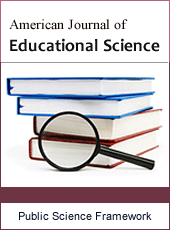American Journal of Educational Science
Articles Information
American Journal of Educational Science, Vol.4, No.4, Dec. 2018, Pub. Date: 16, 2019
A Different “Noticing”: Examining Principal Perceptions of STEM Instruction
Pages: 180-187 Views: 4352 Downloads: 946
[01]
William Sterrett, Department of Educational Leadership, University of North Carolina Wilmington, Wilmington, USA.
[02]
Ginger Rhodes, Department of Mathematics and Statistics, University of North Carolina Wilmington, Wilmington, USA.
[03]
Dennis Kubasko, Department of Instructional Technology, Foundations and Secondary Education, University of North Carolina Wilmington, Wilmington, USA.
[04]
Justin Fischetti, Department of Educational Leadership, University of North Carolina Wilmington, Wilmington, USA.
This exploratory study investigated the instructional perceptions of four middle school principals regarding STEM instruction. By seeking to better understand their own experiences as teachers and administrators, their preferred teaching style, their use of observation instruments, their vision of STEM instruction, and their practices regarding observation and feedback in the middle school level, the researchers sought to provide insights on how principals perceive STEM instruction and their role in working with teachers. Four principals were showed clips of classroom mathematics instruction. As the four principals’ perceptions and feedback varied, it indeed appears that there was a different “noticing” apparent even though these four middle school principals served within the same district and had experience with the same observation protocols and related trainings. Based upon the narratives provided by the four administrators, it was determined that there is divergence in identifying what good STEM instruction is. It is evident from the principal interviews that feedback can vary from person to person even when employing the same observation protocol and training. Given the lack of STEM instruction training for a number of today’s highly qualified principals, it is important to consider how principals interpret STEM instruction, and how they impact teaching and learning. The results suggest that there is distance yet to travel to effectively provide all teachers with the feedback necessary to meet our school based goals of STEM literacy.
STEM Instruction, Mathematics Instruction, Principal, Teacher, Instructional Leadership
[01]
Hallinger, P., & Murphy, J (1987). Assessing and developing principal instructional leadership. Educational Leadership, 45 (1), 54-61.
[02]
Matthews, L. J., & Crow, G. M. (2010). The principalship: New roles in a professional learning community. Boston, MA: Allyn & Bacon.
[03]
Waters, T., Marzano, R. J., & McNulty, B. (2003). Balanced leadership: What 30 years of research tells us about the effect of leadership on student achievement. Aurora, CO: Mid-continent Research for Education and Learning (McREL).
[04]
National Policy Board for Educational Administration (2015). Professional standards for educational leaders. Reston, VA: Author.
[05]
National Board for Professional Teaching Standards (2018). ATLAS Cases. Available: https://atlas.nbpts.org/about.
[06]
U. S. Department of Education (2016), National Center for Education Statistics, National Teacher and Principal Survey (NTPS), "Public School Principal Data File," 2015–16. Available: https://nces.ed.gov/surveys/ntps/tables_list.asp.
[07]
Glickman, C. D., Gordon, S. P., and Ross-Gordon, J. M. (2010). Supervision and instructional leadership: A developmental approach (8th ed). Boston, MA: Allyn & Bacon.
[08]
Spillane, J. P. (2000). Cognition and policy implementation: District policy-makers and the reform of mathematics education. Cognition and Instruction, 18 (2), 141–179.
[09]
Bruce-Davis, M.N., Gubbins, E. J., Gilson, C. M., Villanueva, M., Foreman, J. L., & DaVia Rubenstein, L. (2014). STEM high school administrators’, teachers’, and students’ perceptions of curricular and instructional strategies and practices. Journal of Advanced Academics, 25 (3), 272-306.
[10]
Cotton, K. (2003). Principals and student achievement. Alexandria, VA: Association for Supervision and Curriculum Development.
[11]
Sebastian, J., & Allensworth, E. (2012). The influence of principal leadership on classroom instruction and student learning: A study of mediated pathways to learning. Educational Administration Quarterly, 48 (4), 626-663.
[12]
DuFour, R. & Fullan, M. (2013). Cultures built to last. Bloomington, IN; Solution Tree.
[13]
Glickman, C. D., Gordon, S. P.; and Ross-Gordon, J. M (2013). The basic guide to supervision and instructional leadership. Upper Saddle River, NJ: Pearson.
[14]
Matthews, L. J.; and Crow, G. M. (2010). The principalship: New roles in a professional learning community. Boston, MA: Allyn & Bacon.
[15]
Goodwin, C. (1994). Professional vision. American Anthropologist, 96, 606–633.
[16]
Sherin, M. G. (2007). The development of teachers’ professional vision in video clubs. In R. Goldman, R. Pea, B. Barron, & S. J. Derry (Eds.), Video research in the learning sciences (pp. 383–395). Hillsdale, NJ: Lawrence Erlbaum.
[17]
Sherin, M. G. (2001). Developing a professional vision of classroom events. In T. Wood, B. S. Nelson, & J. Warfield (Eds.), Beyond classical pedagogy: Teaching elementary school mathematics (pp. 75–93). Hillsdale, NJ: Lawrence Erlbaum.
[18]
Jacobs, V. R., Lamb, L. L. C. & Philipp, R. A. (2010). Professional noticing of children’s mathematical thinking. Journal for Research in Mathematics Education, 41, 169–202.
[19]
Munter, C. (2014). Developing visions of high-quality mathematics instruction. Journal for Research in Mathematics Education. 45 (5), 584-635.
[20]
McDonald, S. P. (2016). The transparent and the invisible in professional pedagogical vision for science teaching. School Science and Mathematics, 116 (2), 95-103.
[21]
Lochmiller, C. R. (2016). Examining administrators’ instructional feedback to high school math and science teachers. Educational Administration Quarterly, 51 (1), 75-109.
[22]
DiPaola, M. F. & Hoy, W. K. (2008). Principals improving instruction: Supervision, evaluation, and professional development. Boston, MA: Pearson.
[23]
Yin, R. K. (2012). Applications of case study research (3rd ed). Thousand Oaks, CA: Sage.
[24]
Check, J., & Schutt, R. K. (2012). Research methods in education. Thousand Oaks, CA: Sage.
[25]
Patton, M. Q. (2002). Qualitative evaluation and research methods. Newbury Park, CA: Sage.

ISSN Print: 2381-7127
ISSN Online: 2381-7135
Current Issue:
Vol. 6, Issue 2, June Submit a Manuscript Join Editorial Board Join Reviewer Team
ISSN Online: 2381-7135
Current Issue:
Vol. 6, Issue 2, June Submit a Manuscript Join Editorial Board Join Reviewer Team
| About This Journal |
| All Issues |
| Open Access |
| Indexing |
| Payment Information |
| Author Guidelines |
| Review Process |
| Publication Ethics |
| Editorial Board |
| Peer Reviewers |


